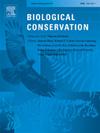Stochastic wind-driven migration likely maintains panmixia in the endangered bogong moth, Agrotis infusa
IF 4.9
1区 环境科学与生态学
Q1 BIODIVERSITY CONSERVATION
引用次数: 0
Abstract
The bogong moth, Agrotis infusa, is critically important for the function of the Australian alpine ecological community. However, anecdotal rapid variability in census size appear to be directly related to climate fluctuations, with long periods of drought in their winter breeding areas leading to large declines in migrating adults. These fluctuations are compounded by basic knowledge gaps regarding their genetic structure and dispersal mechanisms between winter breeding sites and alpine aestivation areas, which hinders conservation efforts and has impacts on threatened animal species that rely upon them. We use thousands of single nucleotide polymorphisms (SNPs) across 349 adult samples collected from 19 locations in southeastern Australia to determine genetic diversity and population structure. We then model wind patterns to determine if prevailing winds can explain measured genetic diversity and how long migrations might take to reach their aestivation sites and return to breeding grounds. We find that the moths have high levels of genetic diversity reflecting a large effective population size and that there is no significant population structuring (e.g., panmixia). The wind modelling indicates that wind patterns could explain random migratory patterns that lead to the observed panmixia, and that adult moths can migrate to, and from, alpine areas in as little as a single night from their winter breeding areas. Taking these data together, we suggest that conservation strategies need to occur range-wide and, in particular, protect breeding sites from land-use change in order to maintain moth migration rates that support the alpine ecosystem each year.
求助全文
约1分钟内获得全文
求助全文
来源期刊

Biological Conservation
环境科学-环境科学
CiteScore
10.20
自引率
3.40%
发文量
295
审稿时长
61 days
期刊介绍:
Biological Conservation is an international leading journal in the discipline of conservation biology. The journal publishes articles spanning a diverse range of fields that contribute to the biological, sociological, and economic dimensions of conservation and natural resource management. The primary aim of Biological Conservation is the publication of high-quality papers that advance the science and practice of conservation, or which demonstrate the application of conservation principles for natural resource management and policy. Therefore it will be of interest to a broad international readership.
 求助内容:
求助内容: 应助结果提醒方式:
应助结果提醒方式:


